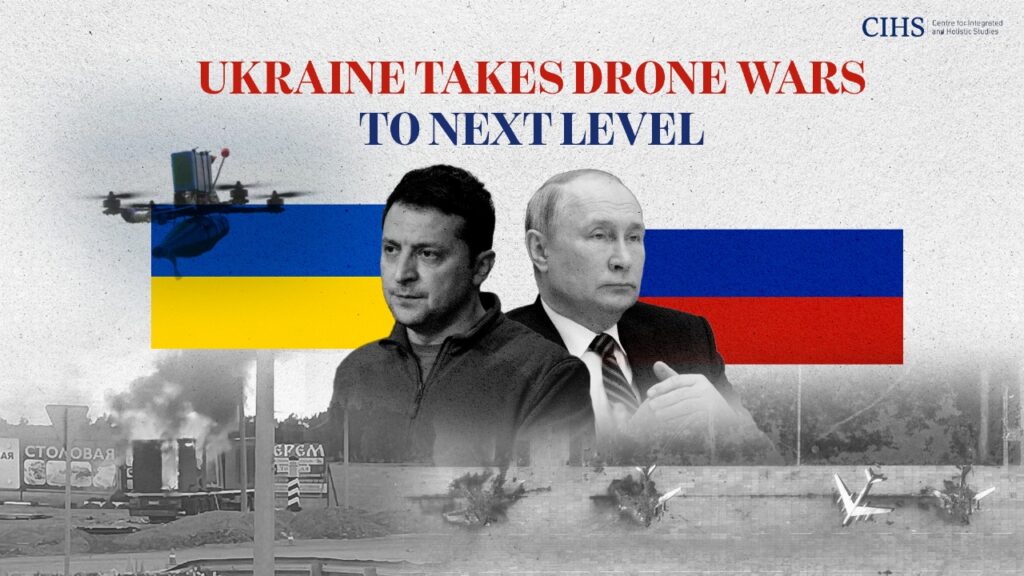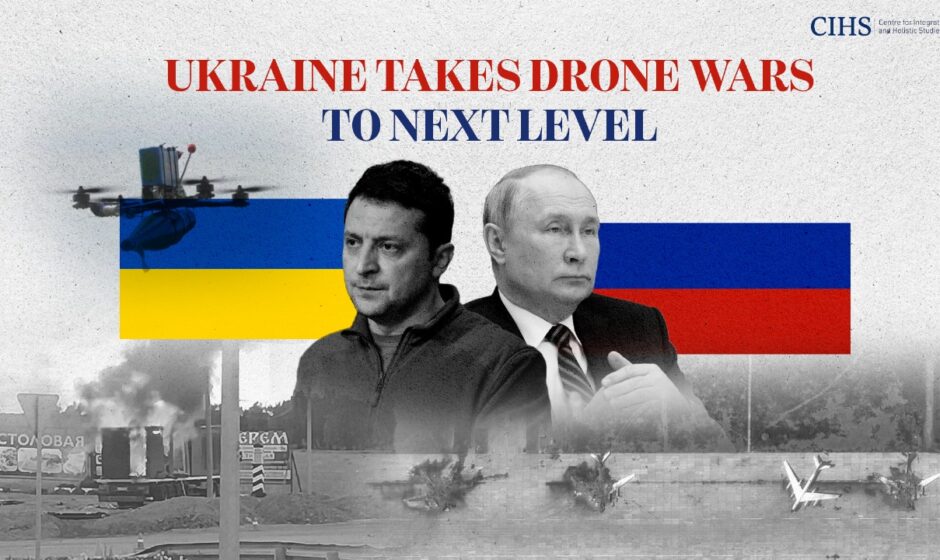From Trojan Horse to pager bombs, Ukraine’s drones have rewritten war tactics while Russia puts up a red face.
N. C. Bipindra
Ukraine’s audacious drone attacks on airbases deep inside Russian territory are so brazen that such tactics have never been attempted before. The targeting of five Russian airbases — one of them over 4,500 km away from the Ukrainian border has reportedly destroyed over 40 military aircraft, including some long-distance bombers that were tormenting Ukrainians for nearly two years now.

The use of cheap, off-the-shelf modified and armed drones is asymmetry in warfare taken to the next level. The drone strikes on June 1, 2025, are now being likened to Israeli Mossad pager bombs that took out a massive number of Hezbollah terror operatives inside Lebanon and the visit of unknown gunmen to wanted terrorists inside Pakistan in recent years.
The drone attacks came after a long-drawn-out plan by Ukrainian military along with its intelligence units. The Ukrainians packed the armed drones onto cargo trucks and hid them with wooden planks under the truck roofs.
Once the trucks reached too close to four airbases that were targeted — Belaya in Siberia’s Irkutsk region, Olenya in Arctic Murmansk area, Ivanovo Severny near Ivanovo city, Dyagilevo in Ryazan and Ukrainka in Russia’s Far East the drones swarms were unleashed on Russian military aviation assets parked there.
While the Belaya base in Irkutsk region was some 4,500 kilometers (2,800 miles) from Ukraine’s border with Russia, the Olenya base near Murmansk in the Arctic Circle was more than 2,000 kilometers (1,200 miles) from Ukraine’s border.
The shortest distances covered by drone-carrying trucks were to Diaghilev airbase in Ryazan Oblast, some 520 kilometers (320 miles) from Ukraine and Ivanovo air base for Russian military transport aircraft was some 800 kilometers (500 miles) from the border.
These visible distances notwithstanding, Ukraine’s daring drone attacks under Operation Spider Web targeted Ukrainka, the furthest airbase at over 8,000 km in Russia’s East, too far away from the war frontline.
In Trojan-horse style attacks, Ukraine launched 117 drones concealed in container trucks, according to one Ukrainian account, striking with precision at airbases across Russia. Ukraine seems to have chosen this covert operation because the Western missiles supplied to it, such as the American ATACMS and European Storm Shadow, lacked the range to reach so deep inside Russia.
Ukraine has been using drones against Russian targets, including Moscow, for last three years now. But majority of these drone attacks have been intercepted by Russians, essentially due to low speed of these unmanned aerial vehicles. Operation Spider Web’s audacity essentially played out due to Ukraine smuggling them into Russia and deploying them next to its target sites.
Russia, obviously, was complacent with security of at least three of the five air bases, comfortable in the thought that it was too deep inside its territory for Ukrainians to even think of targeting them, a devastating mistake in defence preparedness, when military operations were prolonged beyond what was first envisaged when it began in February 2022. Moscow had presumed its airbases and military facilities deep inside its territory were safe, given their distance from Ukraine.
Russia-Ukraine war, progressing for last three years now, has turned the warfare paradigm upside down. Till the Russia-Ukraine war began over Kyiv’s attempt to join the anti-Russia military bloc in the North Atlantic Treaty Organisation (NATO), military thought leadership was talking for nearly two decades about a short, swift and destructive warfare.
Russia’s obvious military strength notwithstanding, its military operations did not result in quick surrender of a comparatively weaker Ukraine. The Russian neighbour a nation that was once part of the Soviet bloc held back the military onslaught for a while and by doing so, got the support of its friends in NATO.
The US, Germany and other NATO nations sent billions of dollars’ worth arms and ammunition, battle tanks, air defence systems and fighter jets to Ukraine for its David vs Goliath moment.
Satellite images, videos and photographs of the damage on these five airbases show Russia’s Tu-160, Tu-22 and Tu-95 nuke-carrying bombers key to their air power were hit badly with plumes of black smoke rising.
Among destroyed air assets of Russia were Ilyushin Il-78 airborne refueling aircraft and advanced A-50 early warning and control aircraft a prized possession for airborne intelligence and radar warnings. Though Russia had tried to protect these assets with decoys, these measures failed miserably.
Whether Western powers were involved in planning and execution of Operation Spider Web will be known later as more details of Ukraine’s attacks on Russia become public. But what could be worrying both Ukraine and NATO nations would be Russia’s response to Operation Spider Web.
Ukraine and its friends in the West would be hoping that Ukraine’s drones circumventing Russian defenses and blowing up their military aviation assets would cause a major psychological blow to Russia’s air force. Truth be told, Operation Spider Web did lift Kyiv’s spirits and it is a dent to Moscow’s morale.
But what they may have discounted is that Russia still holds air superiority overall against Ukraine and it may come back to deliver a crushing blow to Ukrainians at a place and time of its choosing, including an unequal nuclear response. If the nukes get involved in Russia’s war, then it could be game over for both Ukraine and NATO.
The current Russia-Ukraine peace talks in Istanbul have already stalled, with Russian officials signaling no desire for compromise. The Ukrainian drone strike could mean the end of peace with Russia altogether. In response, Britain has announced a £350 million package to supply 100,000 drones to Ukraine by April 2026, reinforcing Kyiv’s growing drone warfare capabilities.
In the second Armenia-Azerbaijan war for Nagorno-Karabakh region in 2020, Azerbaijani forces widespread use of drones was seen as crucial in determining the conflict’s outcome in their favour.
Since then, drone warfare, particularly the asymmetric nature of advantage cheap, easily modifiable unmanned aerial systems bring to the table, has been a major focus of military leadership globally on the evolving character of warfare.
(The writer is a New Delhi-based defence and strategic affairs analyst)



